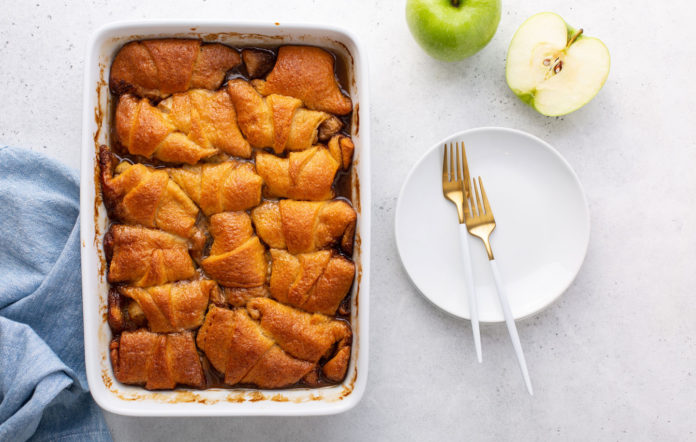“Adam did not want the apple for the apple’s sake; he wanted it because it was forbidden.” —Mark Twain
Home for me in the 1940s was uncle and aunt’s eight-bedroom boarding house in Aberdeen, Wash. My mind is filled with only happy memories, memories that keep my family constantly in my thoughts, especially during the fall season when the smells of ripened apples hang heavily in the air at our local farmer’s markets.
In the cold storage room next to our kitchen were boxes of Gravenstein apples waiting to be turned into apple butter and canned applesauce, and always, apple pies for holiday dinners.
Home refrigerators only had a small ice cube compartment in the late 1940s; therefore canning was the only way to preserve fruit from the home gardens.
During the 19th century, apples made into hard (alcohol) cider was one of the most popular beverages in the U.S., far more popular than beer, whiskey or bourbon, owed, in part, to the widespread availability of cider apples and the ability to make cider in one’s own home.
I, loving fairy tales, remember uncle telling me the story of “John Chapman,” yes, the real Johnny Appleseed, born in Massachusetts and serving as an itinerant missionary under General George Washington during the Revolutionary War.
Johnny was trained as an orchardman, and during his travels, would teach farmers how to grow cider apples with the seeds he provided, asking only a small pittance for his knowledge and time. With that money earned, Johnny would buy some small acreage, plant the seeds, fence the land and then sell it off to a farmer. This would fund his travels.
So, yes Virginia, likened to Santa Claus, truly there was a living Johnny Appleseed.
During the 1929 Depression, businesses in the U.S. were struggling to remain afloat, with customers who had little to nothing to spend. That year the apple industry had a bumper crop with people having little money for food.
The Apple Shippers Association in New York City had an idea to use these apples to help unemployed men. Members of this association purchased $10,000 worth of surplus apples to sell to unemployed men.
The men would buy the apples at a reduced price and then sell them at a profit. The Association gave boxes of apples to unemployed men in New York and other cities. These men would sell them for as much as they could and then pay back $1.75 per box at day’s end. The Association was able to move the surplus apples, and it helped men make some money. But more than that…it gave the men a sense of pride by selling instead of begging.
These men became known as Apple Vendors and were seen on every street corner in New York, selling their apples for five cents apiece. Soon there were 6,000 apple vendors selling every day in New York City alone.
Selling these apples was not an easy job. Weather conditions with rain, sleet and snow, soon followed by heat, so much so that The New York Times in 1930 wrote…” Wherever the little boxes of apples stand a listener has no trouble in getting from the vendor the story of a long period of unemployment, misery at home and of near starvation.”
Over time, the program faded away as the surplus of apples dried up. There were so many sellers they clogged traffic and apple cores became a new mainstay of city trash. Washington, D.C., banned apple vendors, calling them a public nuisance.
Once again, China leads the world in the production of apples, with the U.S. in second place. Mexico and Canada receive most of our exports, with the Red Delicious being the most popular apple variety and Newton Pippin is most popular for cooking/baking purposes. In the U.S., Washington, New York and Michigan are the top growers.
With the busy holiday season soon upon us, it’s time to think of how our precious time will be spent and how to make those holiday dinners, easier.
If your family loves apple pie, try the Apple Dumplings recipe that follows. These dumplings can be made the day before or frozen several days prior to baking. You will be happy you did.
Apple Dumplings with Mountain Dew
(Makes 12 dumplings)
One and one-half cans of 8 Crescent Dinner Rolls
(I bake the remainder 4 rolls in a separate pan, later)
One 9”x12” baking pan, well-buttered.
3 Newton Pippin or Grannie Smith Apples, peeled, cored and cut into quarters.
On a floured breadboard roll out the dinner rolls and with a sharp knife cut through each perforated line carefully.
On the wide bottom of each Crescent roll, lay an apple quarter and roll up. Place in buttered pan with tip of roll pointing up.
In a one quart sauce pan melt:
1 cup of Butter (2 sticks)
Add:
2 Tbsp. White Karo Syrup
1/4 cup white sugar
3/4 cup light brown sugar
2 tsp. vanilla extract
1/2 tsp. cinnamon
1/4 cup brandy (optional)
On low heat, stir until sugars melt. This mixture will be a little grainy and lumpy.
Pour over the tops of the apples in the pan.
Pour 1/2 cup of Mountain Dew, Sprite or 7-Up around EDGES of the apples in the pan. Do NOT pour on top of apples.
Bake at 350deg. for 40 minutes or until puffed and golden.
Colly Gruczelak, a Ben Lomond resident, loves people and loves to cook. Contact her at cz****@*****st.net.













